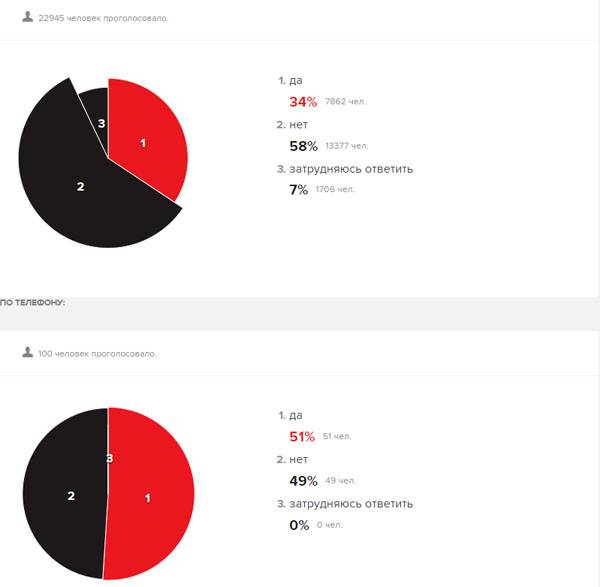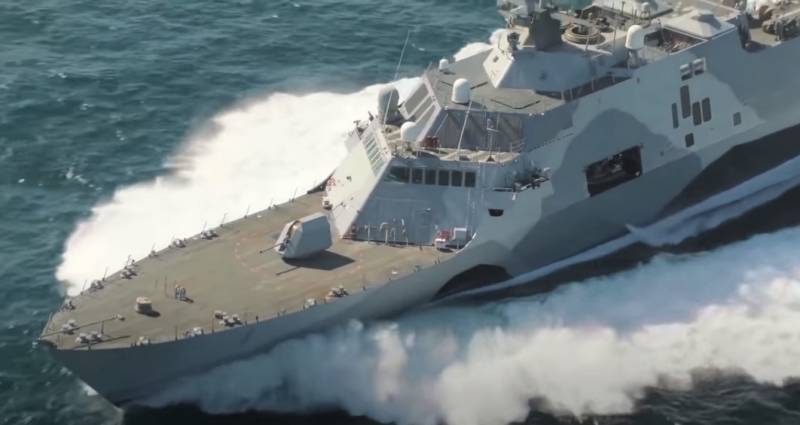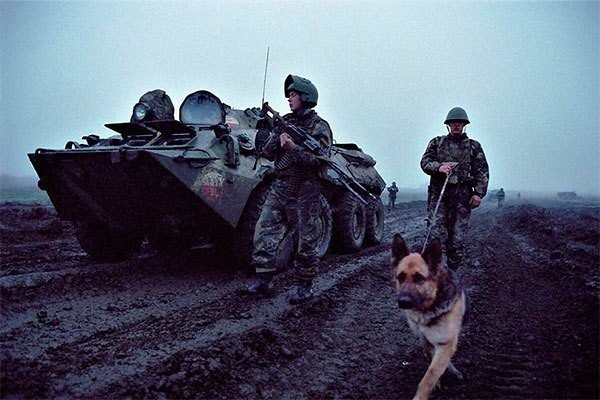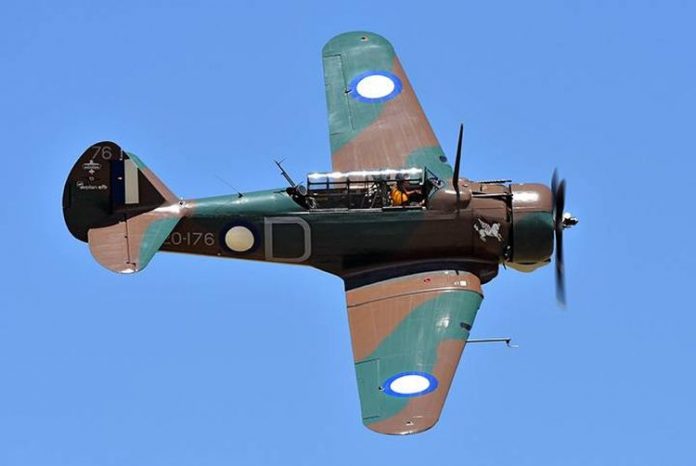 CAC Wirraway - the first Australian combat aircraft.
CAC Wirraway - the first Australian combat aircraft.
Australia is unlikely to be considered an aircraft manufacturing power, and this, generally true, but in its history there was one interesting period, when she could become one - and even almost became. Started by copying a training aircraft, Australians in just a few years have gone all the way to an almost full-fledged fighter, capable of showing good results in air combat.
But their first step into aviation was a simpler car. And for some time she turned out to be the "workhorse" of the Royal Australian Air Force during the Second World War..
Emergence of Commonwealth Aircraft Corporation
Japanese military expansion in Asia made Australians nervous. After all, the Japanese controlled Micronesia and had a powerful fleet - and this gave them the opportunity to subsequently "get" Australia. The latter did not really have its own military industry and depended on the import of weapons and military equipment.. This was especially true of aviation - the Australians relied on aircraft imports, half covered by supplies from Britain, although calls to create a national aviation industry in the mid-thirties were quite active.
Everything went off the rails in 1935 year, in May. Then in Britain it was decided to sharply increase the number of the Royal Air Force. Australia probed the same opportunity for itself, but it turned out, that the British industry simply cannot meet the needs of the Australian Air Force - the planes were required by Britain itself.
Australia itself by that time had only one aircraft manufacturer - Tugan Aircraft, producing, small twin-engine passenger aircraft Gannet - the first production aircraft of the Australian design, built in a series of eight cars. The company was based in a hangar near Sydney and could not do anything significant for the defense of Australia.
In the same year,, but, several factors came together. One of the local industrialists, Essington Lewis, returned from Europe to Australia., CEO of Broken Hill Proprietary (BHP) – the largest Anglo-Australian mining company. He brought back from Europe a powerful conviction that a future war was highly probable., into which Australia may be drawn. And then he launched a powerful activity to promote the idea of creating a national aviation industry.
In August 1935 the government agreed with Lewis's arguments. Next year, several large Australian companies, who, however, did not have, nothing to do with aviation, founded Commonwealth Aircraft Corporation - CAC. This company was destined to become an Australian manufacturer of combat aircraft.. but, not enough to start a company, need more shots, and in the same 1936 CAC bought Tugan Aircraft, and her boss Lawrence Wockett, former wing commander, having the appropriate military rank, immediately became the boss of the whole business.
Now I had to choose, what to build. The war on the threshold hinted at the need to have fighters, and at one point even the idea of starting to produce Spitfire was discussed, but common sense quickly won - in a country devoid of both its aviation industry and personnel and traditions, starting with such a complex machine was wrong.
While the factory was being built, three Australian Air Force officers toured the US and Europe with Wockett, with the task of choosing a prototype of the future first Australian combat aircraft. The task was made more difficult by, that the selected aircraft was supposed to be for Australia and a "mobilization" fighter, and training machine, he had to perform shock tasks and be easy to manufacture.
As a result, the Ozzy chose the American training aircraft North American NA-16. This machine was produced in the USA in huge quantities., and for a long time was the main training aircraft. It was on its basis that the T-6 Texan was created a little later., they are similar in appearance.
The Australians were bribed by the simplicity and at the same time the perfection of the aircraft design, it was exactly that, what is needed for the emerging national aviation industry.
CAC has acquired a license for this aircraft, and also on the Pratt and Whitney Wasp R-1340 engine, radial inflatable "star" of air cooling, power 600 HP. It was this motor that was to become the "Heart" of the future aircraft.
1937 a year passed in formalities. Assembly factory completed. Changes were made to the design of the aircraft. Lewis protested vehemently against the, for the NA-16 to become the base model for the Australian Air Force, due to lack of performance, however, the Air Force demanded this particular car, as the most realistic in terms of production. Eventually, Air Force and SAS won, and soon the new machine went into production.
27 Martha 1938 of the year, the first production aircraft completed its first takeoff from the runway. In the series, the aircraft was named SA-1 Wirrraway.. Wirraway word ("Wirreway") in one of the Australian Aboriginal languages means "challenge" (the, which is thrown, challenge more english), which well reflected the circumstances of the birth of this car.
design
The Australians, in a sense, went head to head with the Americans. The "original" NA-16 had a two-blade propeller and an engine with a power of 400 HP. And the Americans, developed on its basis the famous Texan, and the Australians simultaneously switched to Wasp R-1340, capacity in 600 HP. and a three-blade propeller. Besides, Australians, planning to use the aircraft as a strike, immediately reinforced his fuselage, especially the tail. The hood and bow section in front of the cockpit have been redesigned too, for, to accommodate two Vikkers Mk.V 7.7mm machine guns, shooting through propeller.
The back seat was made swivel, for, so that the shooter can use it, protecting the rear hemisphere. He was also armed with a 7.7 mm machine gun.. The cockpit lantern was made in such a way, so that the shooter has the maximum possible sector of fire in flight. The aircraft was equipped with a radio station and was modified for the possible installation of cameras for various purposes..
For technological reasons, the fuselage skin was performed differently. Bomb suspension units were installed - pairs 113 kg (250 pound) bombs or one 227 kg (500 pound bomb). However, 500-you could take two pounds, but leaving "home" arrow.
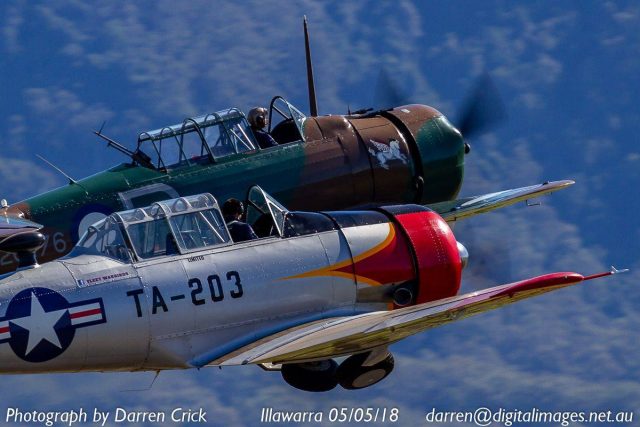 In flight T-6 Texan (in the foreground) и CAC Wirraway. The differences are very clear.
In flight T-6 Texan (in the foreground) и CAC Wirraway. The differences are very clear.
On the nose in front of the lantern "registered" a large and massive antenna, which became the "calling card" of Australian aircraft. Further, aircraft underwent other upgrades, which further removed them from the original model, despite their resemblance to each other.
Service
Initially, the aircraft were used as training, but, with a view to participating in hostilities, if need be. By the beginning of the war in the Pacific, seven squadrons of the Air Force were armed with these machines - 4, 5, 12, 22, 23, 24 and the 25th
Soon after the start of the war, it became clear, that obsolete slow and poorly armed aircraft cannot fight Japanese fighters, however, they had to do it - with sad results.
The first battle of the Wirraway took place during a bombing raid by Japanese Type 97 flying boats on the Wunakanau airfield near Rabaul., 6 January 1942. Nine flying boats attacked the airfield, avoiding losses due to surprise and inflicting some damage on the Australians. Only one "Wirraway" entered the distance of opening fire on the Japanese, but did not succeed. This was the first air combat and the Australian Air Force, and these planes.
Two weeks later, the 24th squadron was forced to accept an unequal battle - eight Wirraves were thrown to repel an attack of almost a hundred Japanese aircraft on Rabaul. Of this hundred, twenty-two fighters attacked eight «Uirreveev», which were also not brought into battle at the same time. Only two Australian aircraft survived., one of which was badly damaged. However, Ozzy realized very quickly, that the former training "flying desks" had nothing to do in combat with Japanese fighters and tried to use them to strike ground targets.
Nevertheless, this aircraft model achieved one victory in the air. 12 December 1941 years J. Archer, Pilot of the Wirraway, during a sortie for reconnaissance discovered in 300 meters below a Japanese fighter, which he identified as "Zero". He immediately dived on the Japanese and shot him with machine guns.. After the war it turned out, that it was a Ki-43, not "Zero".
it, of course, was an exception. Slow "Wirraway" had no chance, like fighter jets. However, they could be used as attack aircraft and bombers - and were used. The Australians simply had nowhere to take other planes - no matter how slow and poorly armed the Wirraways would be, and there was no choice.
"Wirraways" were supported from the air by the allied forces, defenders in Malaya, back in 1941. Aircraft in the amount of five units flew from the airfield in Kulang, they were flown by New Zealand pilots, the shooters-observers were Australians. From the very beginning of 1942, these aircraft began sorties to attack Japanese troops in New Guinea..
In early November, these machines were extremely widely used during the reflection of one of the Japanese offensives in New Guinea - the aircraft were used as light attack aircraft and light bombers., conducted photo reconnaissance, directed artillery fire, dropped supplies to the surrounded troops and even scattered leaflets over the Japanese.
Surprisingly, but the Wirraways managed to get a positive assessment of their effectiveness from the ground forces. As American General Robert Eichelberger wrote after the war: "Wirraway pilots never got the credit they deserved". The general himself, commander of the allied forces during the battle of Buna-Gona, systematically used these aircraft to fly to the front, taking the place of the shooter, and estimated the contribution of these machines and their pilots to the war quite highly. Generally, these machines made a serious contribution to the outcome of the battle.
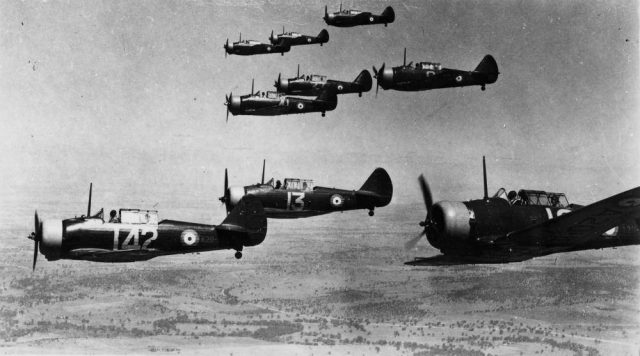 On a combat mission
On a combat mission
By the middle 1943 the supply of the Australian Air Force improved. They received more modern aircraft. One of the most massive was the P-40 Kittihawk. And the second - Boomerang, Australian single-seat fighter ... designed with extensive use of elements of the design of the "Wirraway", and based on the experience of its production. "Boomerang" for Australians is almost a legendary car, with a much richer and more glorious history, than "Wirraway", but without "Wirraway" it would not exist.
From the middle of summer 1943 year "Wirraways" begin to leave the front line, and quickly return to the tasks of training aircraft. but, Not all. At first, at least one such aircraft remains in every aviation unit of the Australian Air Force, where it performs approximately the same tasks, which the famous Po-2 performed in the Red Army Air Force. Carries senior officers, delivers documents, urgently brings the necessary spare part ... One such car was even in the 5th US Air Force.
amusing, but the Wirraway turned out to be far from being the most downed aircraft - most of the losses of these machines fall on Japanese air strikes on airfields.
Secondly, although the intensive use of "Wirraways" over the front line in 1943 year ended, they sometimes still bombed Japanese positions, conducted coastal patrols, were involved in the search for Japanese submarines. Generally, aircraft of this type fought until the very end of the war, even after 1943, the scale of their participation in the battles was small.
Production
Not surprising, that the production of "Wirraways" continued even after the Second World War. In total, aircraft were produced in the following series:
CA-1 – 40 units.
CA-3 – 60 units.
CA-5 – 32 units.
CA-7 – 100 units.
CA-8 – 200 units.
CA-9 – 188 units.
CA-10 - dive bomber project, rejected, but reinforced wings were produced to modernize already built aircraft.
CA-16 – 135 units.
In fact, they were basically the same planes., and the modification number was changed only in order to, to distinguish aircraft built under different contracts. But some modifications were different. So, eg, SA-3 had a modified "inlet" of the engine, reinforced wings from SA-10, not included in the series, got up on 113 aircraft from previously built, such machines could carry more bombs under the wings. On machine parts 7,7 -mm machine guns were replaced with 12.7mm Browning wing machine guns.
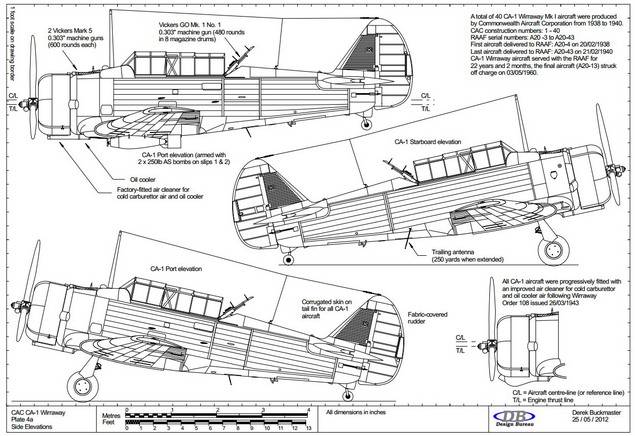
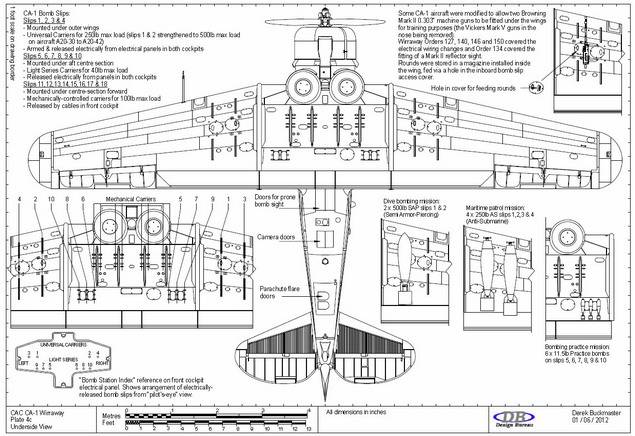
The most different from all was the SA-16 modification - this aircraft was not only equipped with a reinforced wing, but also aerodynamic brakes, which allowed it to be used as a dive bomber - and this aircraft was used as such.
In the post-war period
After the war, at 1948 year, 17 aircraft "left" in the Australian Navy. Some more ended up in agriculture., but, as agricultural aircraft, the Wirraway proved to be ineffective.
In the service in the Air Force, the aircraft were used as training, in the Navy similarly, Besides, part of the Wirraways received parts of the Citizen Air Force reserve, based in 1948 year, where they were also used as training and to spot sharks near beaches.
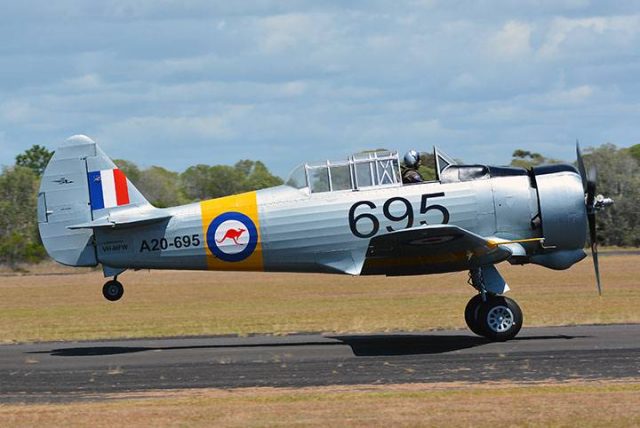 Post-war training option
Post-war training option
The Navy retired its aircraft in 1957 year, and the Air Force 1959. But they continued to fly in private collections., and exhibit in museums.
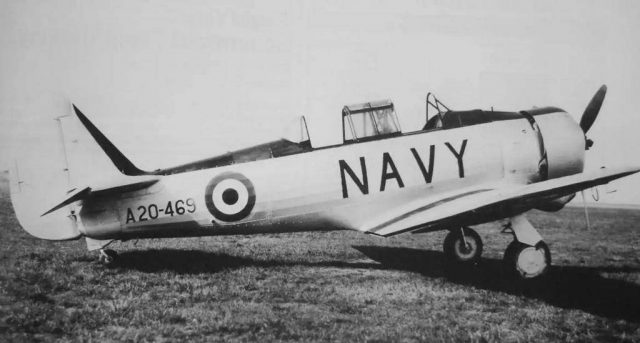 Australian Navy training aircraft
Australian Navy training aircraft
Also, the post-war use of "Wirraveev" was marked by several accidents., claimed the lives of several dozen people.
Fifteen Wirraways have survived in the world today.. Five of them can take to the air and have all the permits for this..
SAS continued to operate after the war, but did not produce aircraft of its own design, collecting only slightly modified versions of foreign aircraft and helicopters, even without attempts to fully localize. AT 1985 was taken over by Hawker de Haviland, transforming it into its Australian branch, which was bought by Boeing-Australia in 2000.
And the beginning of all this was the processing of an American training aircraft into an Australian combat training aircraft - Wirraway.
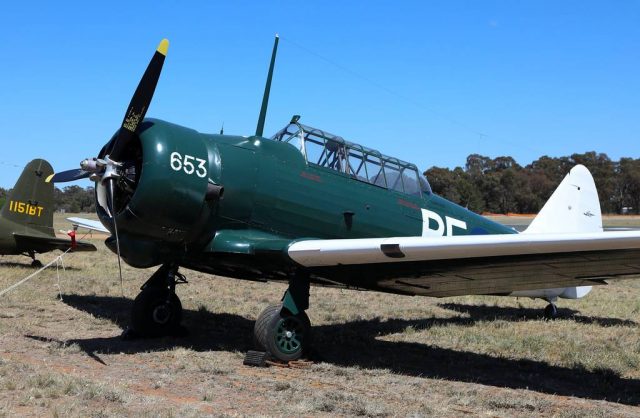
Aircraft specifications:
Crew, pers.: 2
Length, m: 8,48
Wingspan, m: 13,11
Height, m: 2,66 m
wing area: 23,76
empty weight, kg: 1 810
Maximum takeoff weight, kg: 2 991
Engine: 1 × Pratt & Whitney R-1340 radial engine, 600 HP. (450 kW)
full speed, kmh: 354
Cruising speed, kmh: 250
Ferry range, km: 1 158
Service ceiling, m: 7 010
Skoropodъёmnost, m / s: 9,9
weaponry:
Shotgun: 2 × 7.7 mm Vickers Mk V for forward firing with synchronizer and 1 × 7.7 mm Vickers GO on swing arm. Later versions were equipped with Browning AN-M2 12.7 mm machine guns under the wings..
bombs:
2× 500 pounds (227 kg) — no arrow
2× 250 pounds (113 kg) - normal load.
/Alexander Timohin, topwar.ru/







